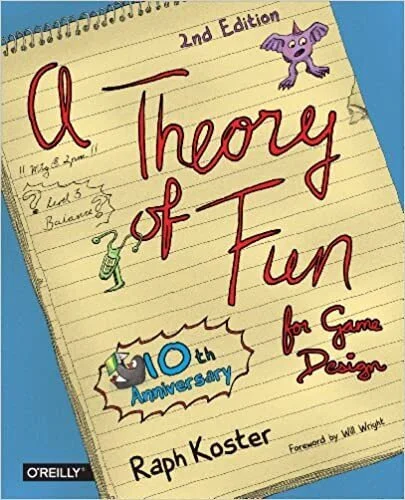Gamification (8): A Theory of Fun for Game Design
Koster, Raph. A Theory of Fun for Game Design. OReilly Media, 2014.
Highly acclaimed as the Creative Director behind the Star Wars Galaxies, Raphael “Raph” Koster is a professional in the game market and is widely recognized as a world-class game designer and speaker. Raph’s book, A Theory of Fun for Game Design, is a classic that is implemented in game design programs at universities worldwide.
I was intrigued by this novel’s friendly tone as I learned more about the psychological approach to designing games. This article will highlight the main points of Raph’s book, so I hope you enjoy this short and sweet read.
Introducing Raph’s Three Definitions of Fun:
Fun is all about our brains feeling good — the release of endorphins into our system.
Fun is just another word for learning. Our brain is seeking new data to refresh the experience. If a game can keep updating data while maintaining the existing experience pattern our brain will be satisfied and we will feel fun.
Fun is the act of mastering a problem mentally.
The “Flow State” often occurs when players are in the mode of having fun, meaning that the game isn’t too hard or too easy. Players strive for the flow state because the easy games can appear dull and hard games can cause players to build anxiety due to their difficulty. Both extremes will trigger players to feel they are unable to continue the game.
Koster, Raph. A Theory of Fun for Game Design. OReilly Media, 2014.
I believe our society today is growing to accept that games can be used as an effective educational tool. For those still in speculation whether this is true or not, I’d like to open a discussion. What exactly do games teach us then? Coming from someone who is a player herself, I find that games help me survive by becoming a problem solver in the real world more so than my previous self before I played games. At a more high-level example, Olympic games encourage us to embrace competition, such as running even just 0.01 seconds faster, aiming at an archery target with keen focus, and taking any necessary precautions to avoid danger. Similar to what our ancestors (i.e. cavemen) have done to protect themselves, like hunting animals for food, we also strive to do what we can to solve our own problems by identifying how we can overcome our limitations.
Games help simplify the overall process and quantify the result. A classic example is chess games where they are most commonly referred to represent military strategies. Chess is considered an abstract way to display strategy with no physical dangers involved, eliminating the unnecessary violence that often occurs in combat.
Early video games have 3 basic paradigms that were notably mentioned in A Theory of Fun for Game Design:
Game designers usually become inspired by existing game concepts and add their own flair with new elements to work on their own game concepts. Raph states that a key difference between game and reality is that “a game is highly abstract by an element’s unnecessary tasks.”
Games quantify and systemize our life, create a pattern and skill sets for players to learn and grow. — Raph Koster
Lastly, here are 5 examples of elements for successful games:
I personally like this quote in the book:
The challenge game designers face is, “How do we create games that do not have one right answer?
In the end, a good game usually teaches us to be open-minded and empathize with each other. In games, there are plenty of different combinations, paths, and interactions being made. Each person playing the same game will come out of it with slightly different, personal experiences. Ultimately, games prove that there is always a way to solve the current situation. And it doesn’t have to be completely boring or unreachable. Games teach us to look at what we currently have with a fresh perspective. For example, some detective games and escape room games do require us to use tools in creative ways. By coming up with various methods, games can arouse creativity for new solutions to our real life. Without actually losing the player’s life or any physical property loss, playing games can let us seek patterns and experiment with different possibilities to solve puzzles.
Citations:
Koster, Raph. A Theory of Fun for Game Design. OReilly Media, 2014.




